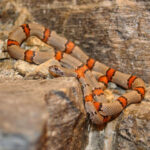Argentine horned frogs, sometimes called Pacman frogs, are native to South America. Many Americans now like to keep them, though. You can breed and raise Argentine horned frogs in your home to sell to pet shops or individuals. Keep in mind the fact that Argentine horned frogs will eat, or attempt to eat, just about anything that moves, including other frogs of the same size. Except when breeding them, keep Argentine horned frogs in separate enclosures to prevent this.
Argentine horned frogs often mistake fingers for food if you move your fingers in front of their faces. They do not have teeth but have powerful jaws and if they clamp down on your finger, it will hurt. Watch where you put your fingers when caring for your frogs.
Make sure you have both a male and a female Argentine horned frog. Both sexes look similar but females grow larger. In addition, males frequently call, especially if you spray them with water, while females are silent.
Place both frogs in a tank with a deep layer of substrate, such as sphagnum moss. Maintain the temperature in the tank at about 70 degrees Fahrenheit. Do not spray the substrate, allowing it to dry out. Provide a shallow bowl of water in case the frogs wish to use it, though they most likely will not. Only feed your frogs if they appear active; most likely they will do nothing but bury themselves under the substrate and sit there. Leave the two frogs in the tank this way for two months.
Simulate a rainy season for your frogs. Place them in a tank of shallow water; their feet should touch the bottom and their heads should be above the top of the water. Provide a place for them to climb out of the water when they wish to do so. Spray the frogs lightly with water several times every day. Frogs will usually lay eggs within three or four days from the beginning of the simulated rainy season.
Remove your frogs from the tank of water as soon as eggs have been laid. Add a few more inches of water to the tank.
Place masses of floating plants in the tank as soon as the eggs hatch into tadpoles, which usually happens in just two or three days. You can use live plants or artificial plants. The plants provide places for tadpoles to hide so that they do not eat each other. Feed the tadpoles live tubifex worms.
Provide places for the little frogs to climb out of the water as the tadpoles begin to transform into frogs, which takes about one month. Remove frogs from the tank as they begin to climb out of the water and place them in separate small enclosures to prevent them from eating each other.
Sources:
Melissa Kaplan’s Herp Care Collection. http://www.anapsid.org/ornatabreeding.html . Breeding Horned Frogs.
The Amphibian. http://www.theamphibian.co.uk/Horned_frog_care_sheet.htm . Horned Frog Care Sheet.




